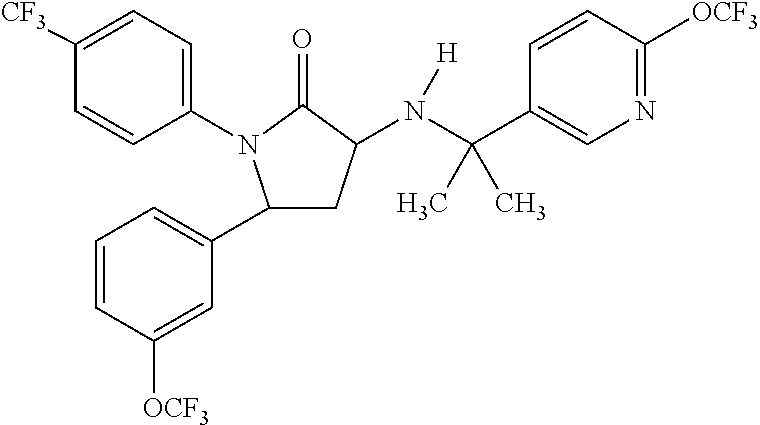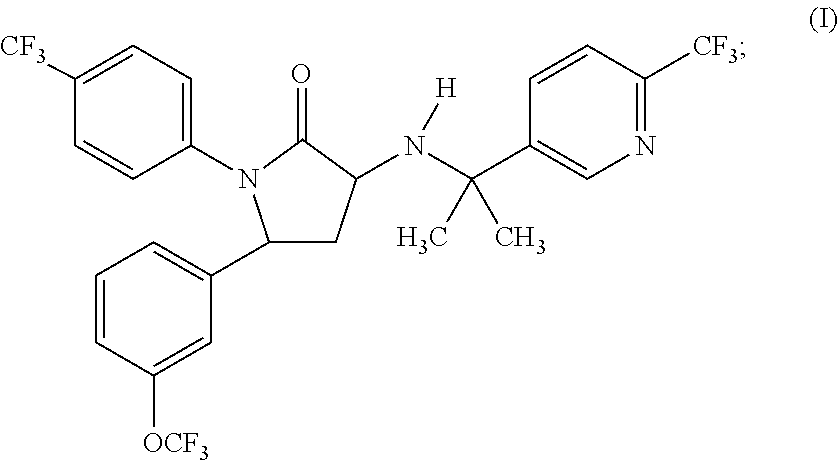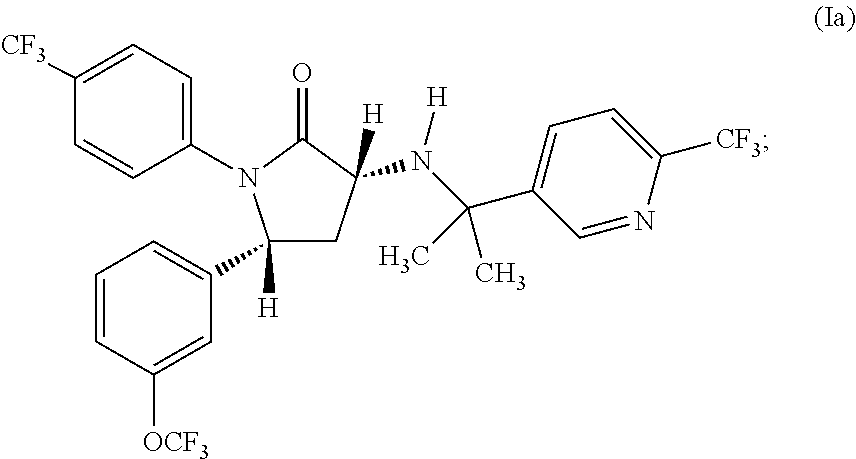1,5-diphenyl-3-pyridinylamino-1,5-dihydropyrrolidin-2-one as CB1 receptor modulator
a technology of cb1 receptor and pyrrolidin, which is applied in the direction of drug composition, biocide, metabolic disorder, etc., can solve the problems of poor oral bioavailability of cbsub>1 /sub>receptor compounds, poor solubility,
- Summary
- Abstract
- Description
- Claims
- Application Information
AI Technical Summary
Benefits of technology
Problems solved by technology
Method used
Image
Examples
preparation b
2-(6-Trifluoromethyl-pyridin-3-yl)-propan-2-ol
[0075]
[0076]Cool the contents of an inerted reaction vessel containing technical grade 6-trifluoromethyl-nicotinic acid ethyl ester (45.6 moles; 10.00 kg) and tert-butyl methyl ether (71.6 L; 53.0 kg) to 10-15° C., and add the solution into a separate inerted reaction vessel cooled to 5-12° C. containing 3 M methylmagnesium chloride (136.8 moles; 45.6 L; 46.2 kg) and tetrahydrofuran (76.5 L; 68.0 kg). Observe a moderate exotherm during the addition, and maintain the internal reaction temperature between 15-25° C. Confirm that the starting ester is completely consumed by HPLC, and cool the reactor contents to 0-3° C. Add the contents from the reaction vessel slowly to a separate reactor cooled to 0-5° C. containing hydrochloric acid (203 moles; 16.67 L; 20.0 kg) and water (81.0 L, 81.0 kg), and observe gas evolution. Separate the layers and extract the aqueous phase once with tert-butyl methyl ether (59.5 L; 44.0 kg). Combine the organic ...
preparation d
1-Methyl-1-(6-trifluoromethyl-pyridin-3-yl)-ethylamine
[0080]
[0081]Heat a mixture of N-[1-Methyl-1-(6-trifluoromethyl-pyridin-3-yl)-ethyl]-acetamide (93.5 moles, 19.1 kg), concentrated hydrochloric acid (805.9 moles; 66.2 L; 79.4 kg), and water (79.4 L; 79.4 kg) to 95-100° C. with stirring under nitrogen for 24 hours. Cool the reaction mixture to 20-35° C. and observe completion of the reaction by HPLC. Cool the reaction vessel to 10-20° C. and add tert-butyl methyl ether (105.4 L; 78.0 kg). Separate the phases, and discard the organic layer. Add 15% sodium hydroxide (910.9 moles; 205 L; 242.9 kg) to the aqueous phase and observe a pH of 9.5-10.5. Extract the aqueous layer with ethyl acetate (3×89 mL; 3×80.0 kg), combine the organic layers, and discard the aqueous phase. Concentrate the solution to approximately 2 volumes, add tert-butyl methyl ether (174 L; 129.1 kg), and concentrate the solution to approximately 2 volumes. Dilute the reaction vessel with n-heptane (168 L; 115.0 kg)...
example 1
(3R,5R)-3-[1-Methyl-1-(6-trifluoromethyl-pyridin-3-yl)-ethylamino]-1-(4-trifluoromethyl-phenyl)-5-(3-trifluoromethoxy-phenyl)-pyrrolidin-2-one, 4-methylbenzenesulfonate (1:1)
[0092]
[0093]Stir (R)-1-(4-trifluoromethyl-phenyl)-3-[(1R)-1-(4-chlorophenyl)-ethylamino]-5-(3-trifluoromethoxyphenyl)-1,5-dihydropyrrol-2-one (50.0 g, 92.4 mmol), toluene (200 mL), and water (100 mL) at ambient temperature for 10 minutes. Add trifluoroacetic acid (50.0 mL, 0.66 mol) to the above biphasic solution and observe a slight exotherm (23 to 30° C.). Monitor the reaction by HPLC (method A), and after 1-2 hours transfer the solution to a separatory funnel and remove the aqueous layer. Wash the organic phase with 5 N hydrochloric acid (200 mL×2), water (200 mL), and assay the organic layer to ensure the removal of (R)-4-chloro-alpha-methylbenzylamine. Place the organic solution into a reaction flask and set aside. In a separate flask mix 1-methyl-1-(6-trifluoromethyl-pyridin-3-yl)-ethylamine hydrochloride ...
PUM
 Login to View More
Login to View More Abstract
Description
Claims
Application Information
 Login to View More
Login to View More - R&D
- Intellectual Property
- Life Sciences
- Materials
- Tech Scout
- Unparalleled Data Quality
- Higher Quality Content
- 60% Fewer Hallucinations
Browse by: Latest US Patents, China's latest patents, Technical Efficacy Thesaurus, Application Domain, Technology Topic, Popular Technical Reports.
© 2025 PatSnap. All rights reserved.Legal|Privacy policy|Modern Slavery Act Transparency Statement|Sitemap|About US| Contact US: help@patsnap.com



